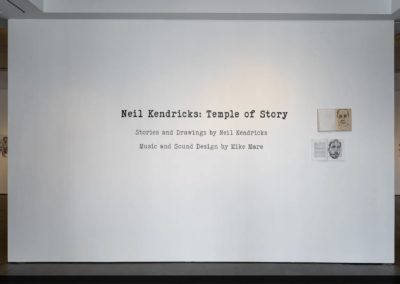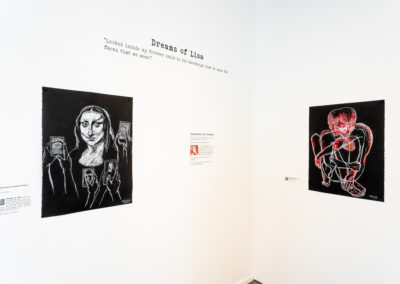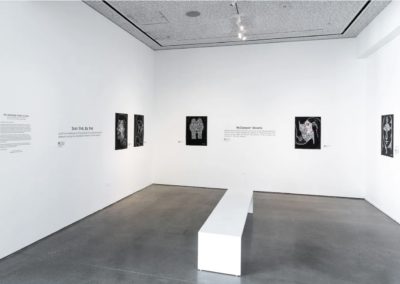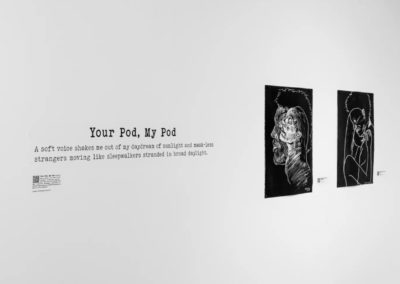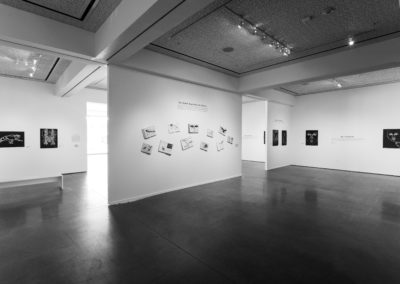Interview with writer/artist Neil Kendricks and composer/musician Mike Mare on Temple of Story
by Caroline Gilman
I didn’t know what to expect as I drove down the coast to the Oceanside Museum of Art. I was pleasantly surprised by the museum and the impressive exhibition by writer/artist Neil Kendricks with music by Mike Mare. The walls were adorned with graphic images, mostly black paper featuring white charcoal-and-pastel drawings, some with pops of red. Quotes from Neil’s short stories graced the panels above the art, adding a layer of story to the initial image. The exhibition’s fusion of images and story excerpts caused me to think a little deeper as I studied the drawings in conjunction with Neil’s words. Next to each image was a QR code, like a key, that unlocked the story behind the artwork. As I scanned the first code with my phone and pressed play, Neil’s voice narrated a cinematic tale that propelled my mind into the art, with Mike’s music luring me away from the floor of the gallery and into the scene of the story.
This interactive experience had many layers, a unique invitation to explore. The visual art, combined with the narration by Neil and voice actress Cheryl Kanekar, were woven together with Mike’s powerful music, creating something truly special. As an aspiring artist and writer, it was an opportunity to peer into the creator’s head and dive into the story behind each drawing. I found myself immersed in the artwork and the stories behind each piece. When I looked up, I realized that over an hour had flown by in what felt like minutes.
I left the gallery feeling inspired, eager to write, motivated to dig deeper, and excited for the opportunity to speak to both Neil and Mike.
Below is a summary from my interview with Local Writer Spotlight: writer and artist Neil Kendricks and musician/ composer Mike Mare, who wrote the fascinating soundtrack for the Temple of Story exhibition. Their collaborative friendship has spanned 15 years, and I enjoyed learning about how they inspire each other through sharing their respective art, ideas, and talents.
Caroline: Let’s talk about Temple of Story. Can you share the process that went into creating this exhibition? Did the artwork come first and inspire the stories, or did you write the stories first and then do the drawings? How did the music become part of the story?
Neil: The stories and the images work in tandem. Sometimes the sketches came first, and sometimes the stories inspired a drawing. Regarding my writing process, I write my stories first by hand. I try to get a (sometimes, illegible) draft down, and then I write a more legible version, and then finally type them out. For me, the sound is what really brings it home. The first time Mike sent me the recordings I cried. It was so beautiful where he had taken these stories. I gave him complete creative freedom and we have a mutual trust in each other. I call him my fellow world builder.
Mike: My process really started with just the story, as not all images had been done. So, I dove into the written word, listened to the recorded audio (of Neil and Cheryl) and edited them to create a flow. It was their voices and the written word that led me down the path to create the music.
Caroline: Much of your work seems very current and tied to socio-political events, including Temple of Story inspired by the pandemic. Where do you get your artistic inspiration?
Neil: Yes, something you will learn is that both Mike and I have a common sensibility that we are both concerned about the world. We are in this perilous moment where artists don’t have the luxury to just make pretty pictures or tell a soothing story. If you look at what has happened in just the last few years, you realize things like the pandemic are serious. Originally, during the quarantine, I was writing these stories as a healing for myself. I started telling the stories and the overarching idea of connecting them started to emerge through the process of about a year and a half of writing.
I also connected with writers online – I found groups such as the Sundance/ Collab Writers’ Café and London Writers’ Salon— and that community was really a life raft at times during the sheltering-in-place quarantine.
Teaching drawing and film history classes, I’ve always been aware that in times of crisis, this is when really interesting and powerful art emerges. I have always felt the drive to contribute to that dialogue and I know that Mike feels the same way with his band and the need to offer commentary. I feel that this is our role right now. It’s not to simply help people escape, but rather to wrap our heads around this experience through creativity, too.
Mike:
In that process of the written word and drawings, even if it is a commentary on the world and life, in general it still is an escape. In Temple of Story, these stories can feel ominous and bleak at times, but they are the opposite. They are beautiful. They have this hope built into them. For my work, I consider myself as an artist rooted in improvisation, therefore, it is reactionary music. I don’t like to overthink things although I do. It is important to make sure that people are aware and present in the moment. Sometimes, it can feel like we live in a terrible place and we all need a coping mechanism. As artists, the coping mechanism, no matter what stories we share, are offering some level of hope.
Caroline: Neil, I found your writing very visual and cinematic. Can you talk about this and what inspires your style of writing?
Neil: I have always been a visual person. My earliest memories are of drawing. It has been my way of navigating through things. I remember being a kid and my Dad, who sadly passed away in 2018, would always bring me stacks of paper.
The writing came later (elementary school/junior high) I took a science fiction writing class in high school and then fell in love with movies at eighteen when my dad took me to see David Lynch’s film Blue Velvet. Something awoke in me that a movie could be like a painting or a great short story or a novel. I wanted to explore this but didn’t have any industry connections. So, I took inventory of what I knew how to do. I knew how to draw and write, so I started to work on short films as a storyboard artist. Before I was even in film school, I built a portfolio. In one case, my drawings were used as a prop in the film and that led to a scholarship for film school at San Diego State University.
I have always been drawn to things that are more experimental. I was more interested in trying to make something that hadn’t existed. What Mike and I created with Temple of Story feels like something new. It doesn’t feel derivative. There are no superheroes, it is grounded in the real world, yet there are elements of fantasy/speculative fiction. In order to buy into this, you have to make the world around it feel real. A lot of my stories including Your Pod, My Pod were inspired by moments. For example, the people in Italy singing to one another during quarantine. Hopefully, when people look back at this time, they will realize that the heroes we really need are ordinary people. The doctors, the nurses, the people who wore masks to protect strangers around them. In the back of my mind, I wanted to keep that at the forefront, and it found its way into my stories. I feel like art in general, the act itself, is an optimistic act. It’s like saying life is worthwhile.
Caroline: I sense that the two of you collaborate quite a bit and not just on this project. Can you share how that process works?
Neil: I send over short stories and then Mike sends back music inspired by my stories. We are actually now going to try it the other way around. Mike is going to share an original piece and allow me to listen and interpret by writing a short story.
Mike: I don’t want to write a piece of music that has a certain feel that takes over Neil’s creative moment. I don’t want it to feel so literal. When I am left to my own devices, it’s a terrible thing. Neil doesn’t know this, but when I was out in San Diego for Temple of Story, I recorded sounds during my trip and I am working on a bigger picture piece where I use these sounds and rework them.
Caroline: I will note that the artistic synergy between the two of them was tangible and something that even I wanted to be a part of. You could feel the inspiration between both Neil and Mike, and the excitement over future ideas.
Caroline: Do you have tips for someone interested in graphic novel writing or someone who wants to learn to write music?
Neil: I don’t think you have to go to school to write prose or music. This is such an extraordinary time where the history of art and music and film are at our fingertips. I encourage my students to immerse themselves in their medium.
I feel like it’s important for artists to use their skills to reflect the times that they live in. Nobody gets to escape this moment in time, what we are experiencing right now. They may want to, and we all do, but it’s an opportunity for them to use their talents, or that impulse to tell stories, or their interest in comic books, to talk about something that is real. Through the lens of science fiction or fantasy, artists can turn the human condition into thought-provoking abstractions. They can draw inspiration from what is happening around them.
Mike: I think it’s about constant education. As you are going through the motions of creating, that is the best education. The process of exploring has led me to find people. I didn’t have a formal music education and as I get older, I am realizing all the things I didn’t know and I am learning them on my own. But I have also found that it has been an advantage to not know the ‘proper way’ to do something. Because of this, I became this obsessed musician, experimenting with sounds from day one. You can’t limit yourselves. Everyone is good enough and I don’t believe in the word ‘perfection.’ Most importantly, we as artists create to get them out of our minds, out of our souls. We are doing creative works to share them. It’s not good to keep it inside. I think the act of sharing is the best education you can give yourself as a creative individual. Take the feedback and learn from it.
Caroline: Where do you see traditional publishing, graphic novels, and the entertainment industry heading with the advancements in technology? You both seem like out-of-the-box thinkers and I wonder how you see things changing?
Neil: I think that is a huge question because everything is changing. I do see the opportunity for things to live on multiple platforms and Mike introduced the idea of adapting Temple of Story into a theatrical production. We are exploring ideas about where it will live beyond the Oceanside exhibition.
I hope that creatives see the rise of technology as a sandbox to play in. I hope that people use the technology to open doors rather than be closed minded or close themselves off. These are just tools. They don’t make you an artist, and they don’t make you creative. They are simply a fancy pencil or a fancy drum kit. They are an iteration of something that stretches back to the beginning. So, I encourage people to stay open and curious. Mike and I are always sharing ideas and things we see, and inspiration comes from our collaboration.
Mike: I’m going to agree with Neil. You have to embrace what is new. It’s tough to keep up and learn how to become a part of new things as they come up. It is going to be a great blend of old mediums and new mediums, which can be a beautiful thing. If you are looking to create and share the beauty is that there are so many different avenues to present your chosen medium or media.
Temple of Story Updates:
Campus Creatives: Featuring San Diego’s Fine-Arts Faculty opened at the Center for the Arts, Escondido and runs through May 15th. The show includes five of Neil Kedricks’ drawings (with the audio recordings for Your Pod, My Pod, Wallpaper Ghosts and Mr. Incognito featuring atmospheric music and sound design by composer/ musician Mike Mare).
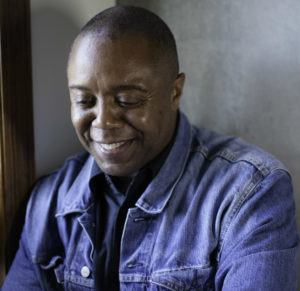 NEIL KENDRICKS
NEIL KENDRICKS
www.neilkendricks.com
Neil Kendricks is an interdisciplinary artist, filmmaker, writer, photographer, and educator. Kendricks earned a Master’s degree in Television, Film and New Media from San Diego State University in 2006. Kendricks participated in Art Produce gallery’s 2020 Artist-in-Residence program where launched his new series of mixed-media drawings titled Strange Fruit.
The San Diego-based artist is also currently searching for completion funds for his documentary-in-progress Comics Are Everywhere!, which has received grants from the 2013 Creative Catalyst Fund/ Individual Artist’s Fellowship and the William Male Foundation’s 2019 Artist’s Grant. His award-winning short films like 2002’s Loop have also screened at numerous international film festivals including the Palm Springs International Festival of Short Films, the Havana Film Festival, and a special short-film screening at the 2003 Cannes Film Festival’s American Pavilion.
Kendricks’ photography has also been exhibited at the San Diego Museum of Art, the now-defunct African-American Museum of Fine Arts, London’s Royal College of Art, and other venues. His first solo photography exhibition, Bruised Eye Candy was shown at San Diego’s Spacecraft gallery in 2008. Kendricks also produced, production designed and storyboarded media theorist Jordan Crandall’s short film, Heatseeking, which was exhibited in the Whitney Museum of American Art’s BitStream exhibition, the first digital-arts exhibition shown at a major American art museum. His new experimental short Book of Skin, will complete postproduction in 2022. Recently, Kendricks’ art was shown in the short-film exhibition Mirror, Mirror: Lights, Camera, Dreams! at Bream & Salt gallery in 2021, and his interdisciplinary art exhibition Temple of Story in collaboration with composer Mike Mare is currently on view at the Oceanside Museum of Art through February 20, 2022. His new drawings are among the works in the group art exhibition Herd Immunity on display at San Marcos’ SIP Studio and Gallery until March 5, 2022.
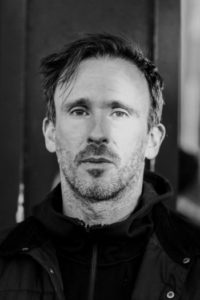 MIKE MARE
MIKE MARE
www.mikejmare.com
Mike Mare has been a fixture of the underground music scene for more than two decades. He’s built up an extensive, diverse discography tied together by a love of sonic exploration for its own sake. He’s a master of mood, a sonic journeyman with a strong, vivid sensibility.
Since the early 2010s, the New York born and raised, Mare has been the co-producer of acclaimed hip-hop outfit, Dälek. Mare brought his unique ear and savvy, technical abilities, helping to refine the band’s pioneering blend of hip-hop, shoegaze, industrial, and avant sounds. He was also the visionary behind Destructo Swarmbots, a DIY noise act that sought and found tension in abstraction, density, and space. His collaboration extends to Anguish, a project including Germany’s Hans Joachim Irmler, of krautrock legends, Faust, and Swedish, free-jazz lifer, Mats Gustafson.
Most recently, Mare has scored the HBO film Betrayal At Attica, the Edward R. Murrow Award winning Short Documentary, New York Seen From Above and released the solo LP, Music For Film, an immersive affair that sits comfortably between John Carpenter’s suspense-laden soundtracks and Brian Eno’s ambient landscapes. It’s visionary work — and suggests that even 20 years on, Mare’s career is only beginning to find it’s path.
1. Precipice LP, Dälek (Ipecac Recordings, Coming Spring 2022)
2. Betrayal At Attica, documentary film by Michael Hull (Fifth Column Films/HBO, 2021) Composer
3. Temple Of Story, Exhibit by Neil Kendricks (Oceanside Museum Of Art, 2021) Composer / Site specific, sound designer
4. New York Seen From Above, documentary film by Zack Taylor (Subset Inc./The New Yorker Documentary Series, 2020) Composer
5. Music For Film LP, Mike Mare (Staywild Industries, 2020)
6. Anguish LP, Anguish (Rare Noise Records, 2018)
7. Endangered Philosophies LP, Dälek (Ipecac Recordings, 2017)
8. Asphalt For Eden LP, Dälek (Profound Lore, 2016)
9. Lay Me Down, short film by Shinako Sudo (2009) Composer
10. Clearlight LP, Destructo Swarmbots (Public Guilt, 2007)

